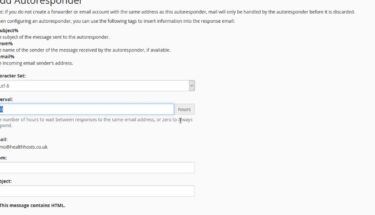Email domain management is a critical aspect of maintaining an efficient and organized communication system for businesses and individuals alike. One essential aspect of this management is creating and removing domain pointers, which allow you to direct emails sent to specific domains to the right destination. In this article, we will delve into the intricacies of creating and removing domain pointers, providing you with a comprehensive guide to help you streamline your email operations.
Creating Domain Pointers
Creating domain pointers is a fundamental step in ensuring that emails sent to specific domains are correctly routed to their intended recipients. This process involves configuring your email server to recognize and process emails sent to the designated domain. Here’s a step-by-step guide to creating domain pointers:
Step 1: Access Your Domain Management Panel
The first step in creating domain pointers is accessing your domain management panel. This is typically done through your domain registrar’s website. Follow these steps:
- Log In: Go to your domain registrar’s website and log in using your credentials;
- Locate the Domain: Find the domain for which you want to create a domain pointer within your domain management panel;
- Access DNS Settings: Look for an option labeled “DNS settings” or “domain management.” Click on it to access the DNS settings or domain management section for the selected domain.
Add DNS Records
Once you have accessed the DNS settings, you’ll need to add DNS records, specifically an MX (Mail Exchange) record. Follow these detailed steps:
- Find the Add Record Option: Within the DNS settings section, search for an option that allows you to add DNS records. The label for this option can vary among registrars but is often named “Add Record,” “Add DNS Record,” or something similar;
- Select MX Record Type: When prompted to choose the type of DNS record, select “MX” or “Mail Exchange.” This record type is used for handling email routing;
- Fill in Information:
- Host/Name: This field is typically left blank or can be represented as “@” to signify the root domain;
- Record Type: Choose “MX” or “Mail Exchange.”;
- Priority: Assign a priority value (e.g., 10, 20, 30). Lower values indicate higher priority. The MX record with the lowest value will be the primary mail server;
- Mail Server/Value: Enter the hostname or IP address of the mail server where you want emails for this domain to be delivered. This is where the emails will be routed.
- Save the DNS Record: After filling in the information, save the MX (Mail Exchange) DNS record.
Step 3: Propagation
It’s crucial to understand that DNS changes may not take effect immediately; they need time to propagate across the internet. The propagation period can vary but is usually within a few hours to 48 hours. During this time:
- Propagation: DNS changes propagate gradually across the internet. This means that the new domain pointer settings will gradually take effect;
- Email Routing: Emails sent to the specified domain will start being routed to the configured mail server as the propagation process advances.
Step 4: Testing
To ensure that your domain pointer is functioning correctly, you should conduct testing. nHere’s how to do it:
- Send a Test Email: Compose and send a test email to an email address that uses the domain for which you’ve configured the pointer;
- Check Delivery: Verify that the test email successfully reaches the intended recipient’s mailbox on the designated mail server.
Congratulations! You’ve successfully created a domain pointer, allowing you to manage email traffic for a specific domain effectively.
Removing Domain Pointers

Sometimes, you may need to remove a domain pointer due to changes in your email infrastructure or other reasons. Removing a domain pointer is a straightforward process, but it should be done with caution to avoid disrupting email services. Here’s how to remove a domain pointer:
Step 1: Access Your Domain Management Panel
- Log in to your domain registrar’s website or access your domain management panel;
- Locate the domain for which you want to remove the pointer and select it;
- Access the DNS settings or domain management section.
Step 2: Identify the MX Record
In the DNS settings, you need to locate the MX (Mail Exchange) record associated with the domain you want to remove the pointer for. Follow these sub-steps:
- Look for a section titled “DNS Management” or “DNS Records.”;
- Find the domain name in question within the list of domains associated with your account;
- Locate the MX record for the domain. The MX record determines where email sent to this domain should be delivered;
- Click on the MX record to edit or delete it.
Step 3: Delete the MX Record
Once you’ve identified the MX record, you’ll need to delete it. Here’s how to do it:
- Select the MX record;
- Look for an option to delete or remove the record. It may be represented by a trash can icon or a similar symbol;
- Confirm the deletion when prompted;
- Save your changes. There might be a “Save” or “Update” button at the bottom of the page. Click it to apply the changes.
Step 4: Propagation
Similar to creating domain pointers, DNS changes, including the removal of MX records, may take some time to propagate across the internet. During this propagation period, any email sent to the domain may be affected, so it’s essential to plan accordingly. Here are some key points to consider:
- Propagation Time: DNS changes usually take anywhere from a few minutes to 48 hours to propagate globally. However, most changes are visible within a few hours;
- Email Downtime: Be aware that during the propagation period, email sent to the domain may not be delivered as expected. Inform your email users about the potential downtime.
Step 5: Verify Removal
To confirm the removal of the domain pointer and ensure that email is no longer delivered to the removed domain, follow these steps:
- Send a test email to an address using the domain in question (e.g., test@yourdomain.com);
- Monitor the email delivery process. It should not be delivered to any mail server or recipient associated with the removed domain.
You have now successfully removed the domain pointer, allowing you to make necessary changes to your email infrastructure.
Conclusion
Effective email domain management is crucial for seamless communication in both personal and business settings. Knowing how to create and remove domain pointers is a valuable skill that allows you to direct email traffic precisely where it needs to go. By following the steps outlined in this guide and keeping the FAQs in mind, you can confidently manage your email domains and ensure that emails reach their intended recipients without a hitch.
FAQs
A domain pointer, specifically an MX (Mail Exchange) record, is a DNS (Domain Name System) configuration that directs incoming email traffic for a particular domain to the designated mail server.
Creating a domain pointer is essential when you want to manage email communication for a specific domain, ensuring that emails sent to that domain are routed to the correct mail server and recipients.
DNS changes, including the creation or removal of domain pointers, typically take a few hours to 48 hours to propagate across the internet. However, propagation times can vary.
Yes, you can modify the priority of an existing MX record. Lower values indicate higher priority, and email servers attempt to deliver email to the server with the lowest priority first.
When removing a domain pointer, ensure that you have a backup plan in place for handling email traffic for that domain. Be prepared for potential disruptions during the DNS propagation period.
The ability to create domain pointers may depend on your domain registrar and hosting provider. Check with your service provider for any specific limitations or requirements.










